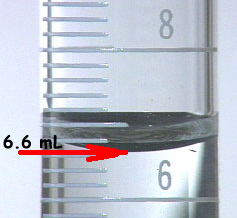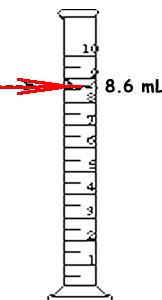![]()
Volume measurements & volumetric containers
Dr. Walt Volland revised June 29, 2013 all rights reserved copyright 2001-2013 |
Lab work is done more often using volume measurements because the tools are inexpensive. Glassware costs less than to use than balances or scales. Glassware is also usually easy to use. Typically the measuring containers have a narrow neck where the calibrations are marked. The error in reading the liquid level multiplied by the area of the 'neck' result in small volume errors. When are surface area of the liquid is large a bigger error results from small differences in reading the liquid level height. The level of the liquid is read at the bottom of the 'meniscus' which is the curved boundary between the liquid and the air. The adjacent images have an arrow indicating the bottom of the meniscus. Plastic containers may have a "flat" meniscus because plastic may does not 'wet' like glass does. |
  |
Here are a few common volumetric containers.
|
Exercises |
||||
| 1. What is a derived unit? | ||||
2. How does the milliliter compare with the cubic centimeter? |
||||
| 3. When measuring liquid volumes what is the meniscus? | ||||
| 4. What is the volume of the liquid in the line drawing graduated cylinder above? | ||||
|
Answers to Exercises |
1. A derived unit results from combining other units, an example is speed, miles per hour, and density, grams / ml. |
2. The ml and cc ( cubic centimeter ) have the same volume. They are equal. |
3. The meniscus is the curved concave boundary between the liquid and the air above it. |
4. If you picked "a' note that the liquid level is above the 8.5 ml mark. |
If you picked "b" you are close but too low. The bottom of the meniscus is above the 8.5 ml mark. |
If you picked "c" you are right. The bottom of the meniscus is slightly above the half way or 8.5 ml mark. |
If you picked "d" you may be misreading the scale. The bottom of the meniscus is slightly above 8.5 ml. |
copyright 2001-2013